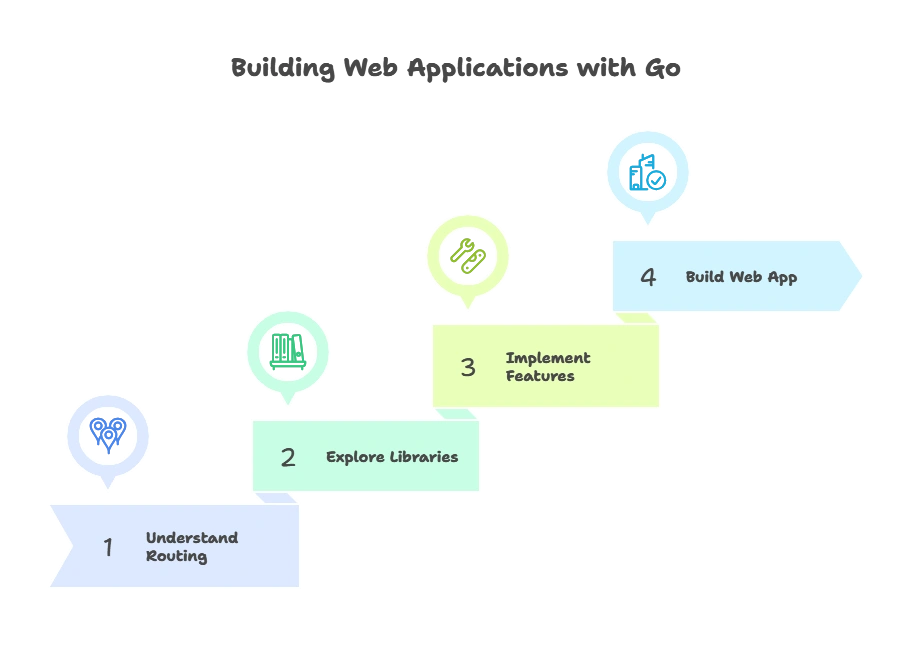Routing with Gorilla Mux or Chi in Go
In this chapter, we will delve into the world of routing in Go web applications using two popular router libraries: Gorilla Mux and Chi. Routing is a fundamental aspect of web development, allowing developers to map incoming HTTP requests to specific handlers. We'll start with the basics of routing and gradually explore more advanced features and techniques. By the end of this chapter, you'll have a comprehensive understanding of how to efficiently route requests in your Go web applications.
Introduction to Routing in Go
Understanding Routing
Routing is the process of determining how an application responds to a client request to a particular endpoint, also known as a route. It involves mapping URLs to specific handler functions, which are responsible for processing the request and generating a response.
Importance of Routing Libraries
While Go’s standard net/http package provides basic routing capabilities, third-party router libraries like Gorilla Mux and Chi offer additional features such as route parameters, middleware support, and sub-routing, making them popular choices for building web applications in Go.

Getting Started with Gorilla Mux
Introduction to Gorilla Mux
Gorilla Mux is a powerful and flexible HTTP router for Go. It offers a rich set of features, including route matching with regular expressions, sub-routing, and support for middleware.
Installing Gorilla Mux
To use Gorilla Mux in your project, you need to install it using Go modules:
go get -u github.com/gorilla/mux
Basic Routing with Gorilla Mux
package main
import (
"net/http"
"github.com/gorilla/mux"
)
func main() {
r := mux.NewRouter()
r.HandleFunc("/", HomeHandler)
r.HandleFunc("/products", ProductsHandler)
http.Handle("/", r)
http.ListenAndServe(":8080", nil)
}
func HomeHandler(w http.ResponseWriter, r *http.Request) {
w.Write([]byte("Welcome to the homepage!"))
}
func ProductsHandler(w http.ResponseWriter, r *http.Request) {
w.Write([]byte("List of products"))
}
mux.NewRouter()creates a new router instance.r.HandleFunc()registers handler functions for specific routes.http.Handle()associates the router with the HTTP server.http.ListenAndServe()starts the HTTP server on port 8080.
Advanced Routing Techniques with Gorilla Mux
Route Parameters
r.HandleFunc("/products/{id}", ProductHandler).Methods("GET")
Route parameters allow you to capture parts of the URL and pass them to the handler function as variables.
Sub-Routing
subRouter := r.PathPrefix("/admin").Subrouter()
subRouter.HandleFunc("/dashboard", DashboardHandler)
subRouter.HandleFunc("/settings", SettingsHandler)
Exploring Chi Router
Introduction to Chi
Chi is a lightweight, fast, and flexible HTTP router for Go. It is inspired by the Express.js router in JavaScript and offers similar features in a Go idiomatic way.
Installing Chi
Similar to Gorilla Mux, you can install Chi using Go modules:
go get -u github.com/go-chi/chi
Basic Routing with Chi
package main
import (
"net/http"
"github.com/go-chi/chi"
)
func main() {
r := chi.NewRouter()
r.Get("/", HomeHandler)
r.Get("/products", ProductsHandler)
http.Handle("/", r)
http.ListenAndServe(":8080", nil)
}
chi.NewRouter()creates a new router instance.r.Get()registers handler functions for HTTP GET requests to specific routes.
Advanced Routing Techniques with Chi
Route Groups
adminRoutes := chi.NewRouter()
adminRoutes.Get("/dashboard", DashboardHandler)
adminRoutes.Get("/settings", SettingsHandler)
r.Route("/admin", func(r chi.Router) {
r.Mount("/panel", adminRoutes)
})
Route groups allow you to define a common prefix for a group of routes and apply middleware or other configurations to them.
Middleware
r.Use(LoggerMiddleware)
Middleware functions are executed before or after each request, allowing you to perform common tasks such as logging, authentication, or request/response manipulation.
Route Middleware
func AuthMiddleware(next http.Handler) http.Handler {
return http.HandlerFunc(func(w http.ResponseWriter, r *http.Request) {
// Check if user is authenticated
if !IsAuthenticated(r) {
http.Error(w, "Unauthorized", http.StatusUnauthorized)
return
}
// Call the next handler
next.ServeHTTP(w, r)
})
}
func main() {
r := chi.NewRouter()
r.Use(AuthMiddleware)
// Define routes...
}
Route middleware allows you to apply specific logic to a group of routes. For example, authentication middleware can be used to ensure that only authenticated users can access certain routes.
Route Prefixing
adminRoutes := chi.NewRouter()
adminRoutes.Get("/dashboard", DashboardHandler)
adminRoutes.Get("/settings", SettingsHandler)
r.Route("/admin", func(r chi.Router) {
r.Mount("/panel", adminRoutes)
})
Route prefixing enables you to define common prefixes for groups of routes. This is useful for organizing routes and applying middleware or other configurations to specific groups.
Route Naming and Reverse Routing
r.Get("/users/{id}", UserDetailsHandler).Name("user-details")
// Generating URL
url, err := r.Get("user-details").URL("id", "123")
Route naming allows you to assign names to routes, making it easier to generate URLs dynamically. Reverse routing enables you to generate URLs based on route names and parameters, improving code readability and maintainability.
In this extended section on advanced routing techniques, we've explored additional topics such as route middleware, route prefixing, and route naming with reverse routing. These advanced features further enhance the flexibility and scalability of routing in Go web applications, allowing you to build sophisticated and efficient routing solutions tailored to your specific requirements. Experiment with these techniques and leverage the full power of Gorilla Mux and Chi routers to create robust and elegant web applications in Go. Happy routing !❤️
